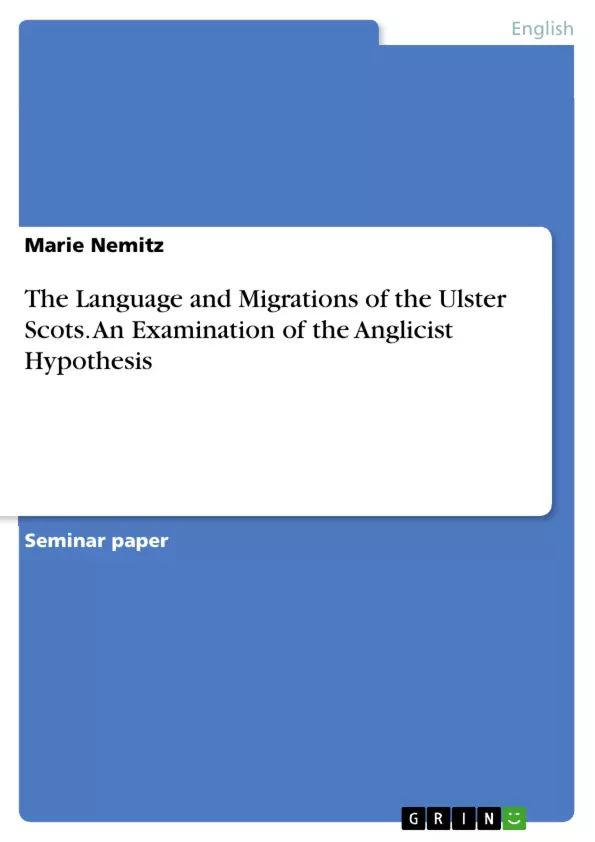There are several theories on how African American Vernacular English (AAVE) may have come into existence, however the creolist hypothesis has been the most prominent one. It states that AAVE is based on a creole and was brought to the United States by slaves from West Africa or the West Indies.
However, the oppositional theory, called the Anglicist or dialectologist hypothesis, considers AAVE to be influenced by traditional English dialects. Most important seems to be the influence of the Scots-Irish from northern Ireland. As they make up the largest group of settlers in the American colonies in the 18th century their language must have had an enormous impact on the emergence of several American English dialects, and probably also on AAVE. This would claim AAVE to be an English dialect as well, influenced by the features of Southern American English. But this is a subject of controversial debate.
Some linguists are of the opinion that the Southern American accent was actually influenced by the language of African Americans. Still, there are several linguistic features of the Scots-Irish' language that can also be found in the United States, especially in the Appalachian and Southern dialect; and it is a “[...] fact that in the New World, i.e. in the United States as well as in the Caribbean, black slaves had extensive contact with people from Ireland” (Ewers, 1995). Thus it is also possible that the American English varieties, primarily the southern one, could have had an impact on AAVE.
Inhaltsverzeichnis (Table of Contents)
- Introduction
- Origin and language of the Scots-Irish
- Scots-Irish' Migration to America
- Planters and Slaves in Charleston, South Carolina
- Gullah
- African American Vernacular English
- Earlier AAVE
- Unique Features of AAVE
- Corresponding Features
- Conclusion
Zielsetzung und Themenschwerpunkte (Objectives and Key Themes)
This paper examines the Anglicist hypothesis regarding the origins of African American Vernacular English (AAVE) by focusing on the influence of Ulster Scots migration to America in the 18th century. It investigates the linguistic features shared between Ulster Scots and Southern American English, including the Scots-Irish language and its impact on the emergence of AAVE.
- The Anglicist hypothesis and its role in understanding AAVE
- The influence of Ulster Scots on American English dialects
- Linguistic features of Ulster Scots and their potential influence on AAVE
- The role of contact situations between African American slaves and plantation owners
- The case of Gullah and its relevance to the debate surrounding AAVE
Zusammenfassung der Kapitel (Chapter Summaries)
- Introduction: The paper introduces the debate surrounding the origins of AAVE, outlining the creolist and anglicist hypotheses. It focuses on the Anglicist hypothesis, specifically the influence of Ulster Scots, and highlights the importance of examining the migratory patterns and linguistic features of this group.
- Origin and language of the Scots-Irish: This chapter explores the historical context of Ulster Scots migration, tracing their roots back to Scotland and their settlement in Northern Ireland. It examines the distinctive linguistic features of Ulster Scots, including phonological aspects, grammar, and lexicon.
- Scots-Irish' Migration to America: This chapter delves into the reasons for Ulster Scots migration to America, including religious persecution and economic hardships. It outlines their settlement patterns, focusing on their westward movement to Appalachia and the Carolinas, and describes the distinct cultural and linguistic characteristics of the Scots-Irish community.
Schlüsselwörter (Keywords)
African American Vernacular English (AAVE), Anglicist hypothesis, Ulster Scots, Scots-Irish, Southern American English, linguistic features, migration, contact situations, Gullah, creolist hypothesis.
- Quote paper
- Marie Nemitz (Author), 2014, The Language and Migrations of the Ulster Scots. An Examination of the Anglicist Hypothesis, Munich, GRIN Verlag, https://www.grin.com/document/356875



